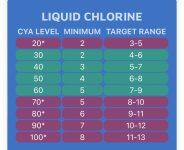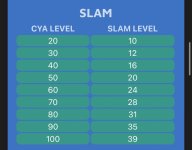Long story, but we had a "pool guy" open up this year as he was coming out here anyway and I thought it'd save me some work. It didn't.
I've now got the pool clean and water clear and sparkly. After shocking, the chlorine level fell back to 2.0ppm and for a day or two I had free chlorine of 2.0ppm and total chlorine of 2.0/2.1ppm. Fine. In previous seasons, that's been about where I've been able to maintain consistent chlorine level. Unfortunately, this time after the first day or two that dropped to 1.0ppm and 1.2ppm despite adding chlorine. I shocked again, and again the same story, below 1ppm and falling. To me that suggests there's still some organic stuff in the pool using up the chlorine. But how?
I have a "suspicion" that the pool guy vac'd all the debris - including really fine silt and stuff that settles on the floor after the chlorine shock's done it's thing - into the filter, rather than to waste as I would do. That's backed up by the fact the water level didn't change and wasn't topped up, and by the fact that when I did a backwash the water in the filter was dark brown and foamy. I've now backwashed 3 times, and although the water's now clear, there's a lot of floating crud and bugs etc in the filter. I'm hoping repeated backwashing over time might clean it up a little.
Is it *possible*, if super-fine silt is vac'd into the filter, that the filter is just slowly releasing some of that fine organic silt - too fine to see, but enough to use up the chlorine - back into the pool? Is that even a thing??
I've now got the pool clean and water clear and sparkly. After shocking, the chlorine level fell back to 2.0ppm and for a day or two I had free chlorine of 2.0ppm and total chlorine of 2.0/2.1ppm. Fine. In previous seasons, that's been about where I've been able to maintain consistent chlorine level. Unfortunately, this time after the first day or two that dropped to 1.0ppm and 1.2ppm despite adding chlorine. I shocked again, and again the same story, below 1ppm and falling. To me that suggests there's still some organic stuff in the pool using up the chlorine. But how?
I have a "suspicion" that the pool guy vac'd all the debris - including really fine silt and stuff that settles on the floor after the chlorine shock's done it's thing - into the filter, rather than to waste as I would do. That's backed up by the fact the water level didn't change and wasn't topped up, and by the fact that when I did a backwash the water in the filter was dark brown and foamy. I've now backwashed 3 times, and although the water's now clear, there's a lot of floating crud and bugs etc in the filter. I'm hoping repeated backwashing over time might clean it up a little.
Is it *possible*, if super-fine silt is vac'd into the filter, that the filter is just slowly releasing some of that fine organic silt - too fine to see, but enough to use up the chlorine - back into the pool? Is that even a thing??



